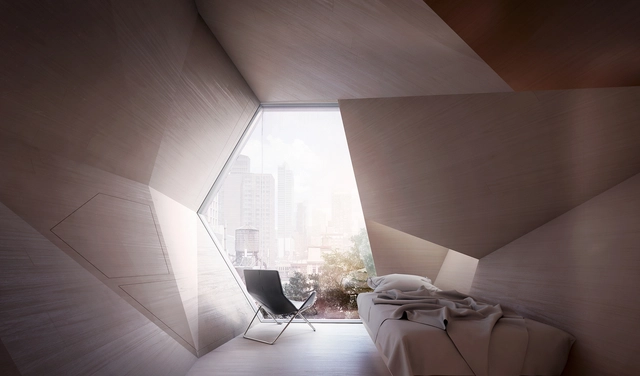
The Hilda L. Solis Care First Village (HSCFV), a large-scale interim housing project providing a wide range of amenities for both the unhoused and those in transition, recently opened in Downtown Los Angeles.


The Hilda L. Solis Care First Village (HSCFV), a large-scale interim housing project providing a wide range of amenities for both the unhoused and those in transition, recently opened in Downtown Los Angeles.

Morris + Company has unveiled images of their competition-winning vision addressing London’s homelessness crisis. The M+C scheme, produced for the New Horizon Youth Center and Mayor of London-led competition, repurposes the abandoned York Road tube station into a hostel and co-working space.
Titled “Stepping Stones”, the project seeks to provide “an inclusive, viable, and holistic site strategy that can support a managed and balanced community by providing homeless young residents with a sage, supporting stepping-stone into appropriate long-term housing solutions.”

Los Angeles-based KTGY Architecture + Planning’s Research and Development studio has unveiled an idea to reuse millions of square feet of empty retail stores as housing for the homeless. The “Re-Habit” concept calls for the installation of bathrooms, dining, sleeping, gardening, and job training facilities, transforming obsolete big-box stores into agents of social change.
The concept comes at a time when vast big box stores such as Macy’s, JC Penney, and Sears are closing in record numbers, leaving large vacant footprints throughout the urban landscape.

In the last global survey undertaken by the United Nations in 2005, there were an estimated 100 million people who were homeless around the world and 1.6 billion who lived without adequate housing. This number has escalated in recent years; unaffordable housing has become a global norm, making it increasingly difficult for the disadvantaged to seek out permanent, or even temporary shelter.
As housing becomes a means of accumulating wealth rather than fulfilling its fundamental goal of shelter, well-intentioned architects have attempted to solve the homelessness crisis through creative ideas and innovative design. But is architecture really the solution?

Across the world, homelessness in fast-paced metropolises such as New York City is at a record high since the Great Depression of the 1930s, more than 60,000 people are in shelters every night while many others must find a place to sleep on the streets, the subway or other public spaces. The real estate industry has caused the increasing rents and a high demand for any remaining plots; many of the new builds are luxury apartments, rather than the low-cost housing that is so desperately needed. As a result, thousands of people are forced onto the streets and charities struggle to provide adequate help for everyone.

Aggravated by limited upward mobility and a dire housing crisis, LA County’s homeless population has shot up 23 percent to nearly 58,000 in the past year alone, according The Los Angeles Times. Their increased visibility recently guilted voters into passing (by a two-thirds majority) a sales tax increase (Measure H) and a $1.2 billion bond initiative (Measure HHH) to provide housing and amenities. With the city now better financially equipped to tackle the problem, a new issue arises: what to build?

WE Architecture + Erik Juul have been awarded a commission to transform a vacant lot at Jagtvej 69 in Copenhagen into a urban garden and housing structure that could provided temporary accommodation for homeless people, helping them to turn their lives around.
The architects describe the project as a place “where housing and green gardens [create] a platform for the meeting between locals and homeless, and a path for a new beginning.”

To many, the harsh turns the modern city has taken are not apparent. We see benches and bus stops that masquerade as shelters, but Guardian writer Alex Andreou's sudden plunge into homelessness opened his eyes to the hostile realities of these and other structures. In "Anti-Homeless spikes: 'Sleeping rough opened my eyes to the city's barbed cruelty'," he sheds some light on misconceptions about homelessness and explains the unfortunate trend of designing unlivable architecture to deter those affected.

As the need for smart housing solutions rises, so does the appeal of tiny-house villages, not just as shelter for the homeless, but as a possible look to the future of the housing sector. The new article, Are Tiny-House Villages The Solution To Homelessness? by Tim Murphy, takes a closer look into the positive and negative aspects of these controversial communities, as well as their social and political ramifications so far. Through interviews with residents of several tiny-house villages, Murphy investigates the current impacts they have had on the homeless populations within major American cities, and questions how the lifestyle will evolve in the future. Read the full article, here.
The problem of homelessness challenges city governments all over the world, one which, despite many attempts by governments to curb the problems that lead to homelessness, does not seem to have a simple solution. What's more, with many countries still deep in the global economic crises, many governments and non-profits struggle to provide an adequate amount of temporary shelter for the homeless population.
But what if we could make temporary accommodation for the homeless pay for itself? And what if we could provide it by leveraging structures that would be built anyway? This is exactly the approach taken by Michal Polacek, Matej Nedorolik and Martin Lee Keniz of Project Gregory, whose design for small roadside accommodation built into an advertising billboard is currently on Kickstarter.

Gwynne Pugh Urban Design Studio, in conjunction with garcia architecture + design, was recently selected from a pool of sixteen firms to design the new CAPSLO Homeless Services Center located in San Luis Obispo, California. Since 1997, there have been two shelters providing services to the homeless community. However, when the county offered a site, it was determined that a consolidated center would be able to operate much more efficiently, 24 hours a day. More details after the break.